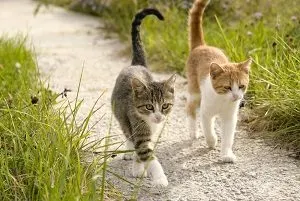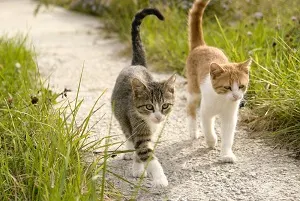 Cats have a long-standing reputation for their agility, gracefulness, and lightning reflexes. Their unique balance and walking patterns have always been a topic of discussion, especially when it comes to walking backward. With all of their many catly advantages, you might be wondering, can cats walk backwards?
Cats have a long-standing reputation for their agility, gracefulness, and lightning reflexes. Their unique balance and walking patterns have always been a topic of discussion, especially when it comes to walking backward. With all of their many catly advantages, you might be wondering, can cats walk backwards?
Cas can walk backward. Cats can reverse their stride and walk in a straight line while using their tails for balance. Some cats may be experiencing feline cognitive dysfunction which can result in awkward walking patterns. A cat will often look over its shoulder to prevent itself from falling as it retraces its steps backward.
Although walking backward is within the realm of normal for cats, they don’t do it often. The information you find here will help you determine if your cat is behaving as a healthy cat should. If you’re a cat parent, you must tune into your cat’s behavior patterns to be alert when something is out of the ordinary. In addition to a cat’s meow, cats communicate regularly through their expressive body language.
Responding appropriately to your feline’s cues will strengthen your bond and help your pet feel safe and loved. Keep reading to find out if your cat’s stride falls under the category of typical feline behavior or if it’s something of concern.
Why Do Cats Walk Backward
Cats will choose to do the backward shuffle for a variety of reasons.
Some of them are related to a cat’s inherited nature of hunting and surviving in the wild.
Even though your average domestic feline has little to worry about in regards to hunting or being hunted, especially if it’s an indoor cat, it still carries deeply rooted evolutionary programming that influences its behavior.
A cat finds itself in the middle of its food chain by playing the role of both prey and predator. While the cat is busy hunting small animals like mice, birds, and rabbits, it faces the fear of being targeted itself by larger animals like coyotes and birds of prey.
That’s why cats have a soft spot for high places. Whether it be a tree, the roof of your house, or the top of your refrigerator, this light-footed animal finds its comfort by looking down on the world below it.
From its lofty perch, a cat can remain safe from threats on the ground and also use this vantage point to find its next meal.
With their fantastic sense of balance, the cat is famous for its high-wire act on fences, balconies, and the beams of your house.
A cat may walk backward after strolling along a narrow wall or ledge and discovering that there isn’t enough space to turn around.
Another reason is to get themselves out of tight spaces.
Many curious cats have been known to get themselves into tight situations. Cats have been seeking out the shelter of closed spaces for centuries to hide from larger animals and to use as cover from which to hunt their dinner.
When a cat is in a small space, it feels safer knowing that it won’t be surprised from behind.
Sometimes a cat makes a judgment about exploring a particular space – and judges wrong! In this case, the cat will slink backward to extract itself from becoming stuck.
Can All Cats Walk Backward
It seems that from a muscular standpoint, all cats enjoy similar functioning across the board. So yes, all cats can walk backward like most other animals.
As far as behavior goes, not all cats are created equal. In a study done on Maine Coon, Ragdoll, and Turkish Van breeds of cat, scientists found that they varied in levels of personality, including aggression vs. shyness towards strange people or objects.
Can Kittens Walk Backward
Yes, kittens can walk backward just like adult cats!
From a young age, kittens grow into the mobility, agility, and flexibility talents of their older counterparts. If you see a kitten walking backward that is entirely normal. Kittens are just beginning to understand their bodies and oftentimes appear disoriented. There is no need for concern in this situation though. As a kitten develops and understands their body, their balance and awareness will increase.
Why Is My Cat Walking Backward When Wearing A Cone
Sometimes the dreaded “cone of shame” is necessary to help your pet heal completely after returning from the vet. Usually, an animal will instinctively lick its wounds to aid in the healing process.
The cone is designed to prevent your furry convalescent from causing further damage to its injuries by licking, scratching, or biting the affected areas.
Since cats don’t understand that this foreign object is supposed to help them, they think their heads are stuck!
A cat’s first instinct when stuck is to jerk backward, trying to get free. You’ll see the same behavior if your fascinated feline ever took a nosedive into a fast-food bag or box that was a bit too small for its head.
If your cat is walking backward after receiving its newest fashion accessory, don’t panic. Most cats will adjust to this temporary addition in a short amount of time.
You can help your cat adjust to its cone by introducing it to your furry friend before it becomes necessary. Rewarding your feline with treats while you put it on and take it off can train your cat to associate it with positive things.
If you have a growing concern that the cone is causing more distress than seems typical, consider asking your vet about other, softer material options such as cloth or foam. Some even switch it up and cover the cat’s body (and injured areas) instead.
Why Is My Cat Walking Backwards After Surgery
Walking backward, among other unusual behavior, is a symptom sometimes seen in cats following spaying, rear-leg amputations, or other surgeries.
Unfortunately, it’s not clear what causes this behavior. In the case of rear-leg amputations, some vets think it might be attributed to muscle spasms, or perhaps the now three-pawed feline keeps trying to find stability where the missing limb used to be.
The good news is that cat owners who watched their pets go through these challenging stages reported that their resilient felines stopped this distressing behavior after a week or two.
If you find your new amputee walking backward or in circles, ask your vet about medications with nerve-calming properties.
Why Is My Cat Disoriented
Disorientation in cats can be caused by a variety of disorders or environmental factors.
Here are some of the most common:
Feline Cognitive Dysfunction
As cats live longer under better home conditions, they are more likely to exhibit signs of disorders that come along with aging. Feline cognitive dysfunction is a degenerative condition similar to Alzheimer’s or dementia in humans. Symptoms of feline cognitive dysfunction tend to manifest in cats ten years or older.
Symptoms include:
● Loss of spatial awareness and navigation, wandering
● Uncontrolled soiling
● Decreased energy and playfulness
● Decreased appetite
● Altered sleep cycles
● Loud night vocalizing
While there is no cure for feline cognitive dysfunction, you can take action to slow the progression of this disorder. Changes in diet, introducing supplements, and mental stimulation are a few examples.
Feline Vestibular Disease
The vestibular system is responsible for an animal’s spatial orientation and balance and helps cats in their backward walks. Problems with the vestibular system in cats result in their inability to stand squarely without wobbling and often walking in circles. Their heads tilt to one side while their eyeballs move rapidly back and forth. These behaviors can occur without warning in cats of all ages.
Fortunately, the feline vestibular disease is usually temporary and often resolves on its own. If it comes about as a secondary effect of a condition like an ear infection or as a reaction to a new drug, treatment will require addressing the initial cause.
Toxins
As a cat lover, you want to make sure that your house is free of poisons and toxins that can be dangerous to your beloved feline. Certain toxins can cause your cat to act disoriented, like rat poison, raw bread dough, and even alcohol.
If you are concerned about your cat walking backward or exhibiting any behavior out of the ordinary, call your vet immediately. Every minute counts in getting to the bottom of what’s bothering your cat and could save his or her life.
Final Thoughts
If you find your cat walking backward around the house, you can observe them in peace. Cats do this sort of walking behavior all of the time. Normally, a cat will walk this way when they are taking a defensive position, stretching, or exploring something they are unfamiliar with.
If you find your adult cat is disoriented and acting highly unusual, then get them to the vet. Chances are more could be going on.

My name is James, and welcome to FAQCats!
Along with our team of cat owners, expert pet enthusiasts, and pet professionals, we aim to write engaging helpful, engaging content about cats. At FAQCats we strive to provide content that’s accurate and fun to read. Our team writes about everything related to cats; even the most complex of topics. Through extensive research and caring for our own fur-pals, we’re able to provide something cat owners worldwide will love. Have a look around, and leave us feedback anytime!

